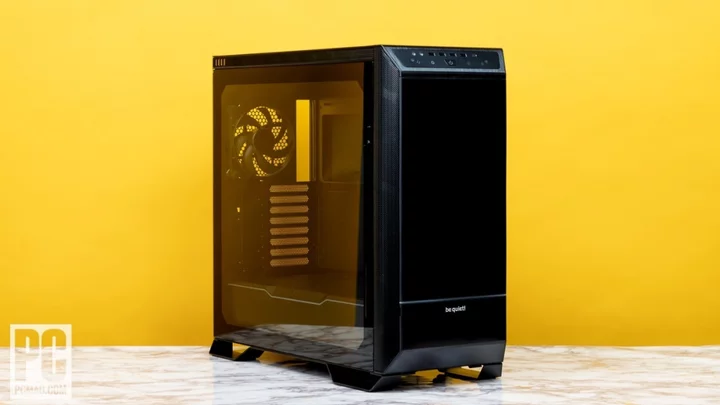If you name your company "Be Quiet," your PC cases had better be extra hushed-up. And let us be the first to say that the German firm's latest chassis, the $299.99 Dark Base Pro 901, simply screams quality—into a pillow. We're looking at a PC case here that includes everything from triple three-fan radiator mounts to a wireless smartphone charging panel on top, in a handsome steel structure that weighs more than 35 pounds. This flagship case costs a bundle, and we didn't find it the overwhelming performer that its size and price suggest it should be, though it's certainly no slouch. But it could well be the high-performance tower that you keep for the ages, for its superior looks and style.
The Design: Deluxe Materials and More
Most of the surfaces on the Dark Base Pro 901 that aren't vented, or tempered glass, are covered with black anodized brushed-aluminum inserts. That includes the facia and lower drive-bay door, the front port area, and the frame surrounding the top-panel wireless charging pad and vent.
Yes, we said "lower drive-bay door": There's a single 5.25-inch external bay hidden at the bottom of the 901's front panel. The only obstacles preventing most users from putting something there are (1) that the drive bracket replaces the internal 3.5-inch drive cage, (2) that the center latch is designed in such a way that the door may not open, and (3) that you might like to leave a coffee cup in front of the PC sometimes. Of those three complications, we were able to get the front panel's center tabs to release the center knob of the door panel only by removing the panel from the chassis and bending the tabs apart until they no longer functioned. This after almost breaking off the tabs while trying to pry the door open, only to find they tightened, finger-trap-style, as we pulled.
(Credit: Thomas Soderstrom)The front-panel ports include four USB 3.2 Gen 1 Type-A and one USB 3.2 Gen 2x2 Type-C. Front-panel audio jacks are separate, which preserves the stereo function of the microphone jack in case you'd like to reassign it as an output, which may become more important to multichannel audio fans as motherboard manufacturers continue to decrease the number of audio jacks on their rear panels.
The Be Quiet's internal fan controller can take commands from the motherboard (hence the sync button) or ignore them (hence the speed buttons), and the ARGB control buttons on the opposite side of the front panel do the same thing in a different way: The case provides monochromatic light patterns, but supports multicolor patterns provided by the motherboard after synchronizing one of its ARGB outputs.
The Qi wireless phone charging pad mentioned above appears here, behind the front-panel ports, at the front of the top panel.
(Credit: Thomas Soderstrom)When we said "most" surfaces were covered with brushed aluminum, we were leaving room for the two panels that Be Quiet didn't put much extra appearance work into: the right-side and rear panels, which are both finished in textured black paint. A vent at the front of the right panel feeds an optional radiator mount, its mesh filler providing the only bit of flair visible from this angle.
(Credit: Thomas Soderstrom)Behind the right panel's open vent is—you guessed it—a sheet of noise-dampening acoustic foam.
(Credit: Thomas Soderstrom)The right panel's vent might attract more attention, but the Dark Base Pro 901's rear panel may prove just as influential among builder choices: You can rotate its slot panel 90 degrees to support vertical-mounting a graphics card, and a removable power supply bracket allows insertion of the power supply through the case's back panel.
(Credit: Thomas Soderstrom)Both the top and front panel feature vents at the sides, but that's where the similarities between them end. By default, the top panel's mesh cover hides a 2x120mm and a 1x120mm fan cover, which in turn hides a 3x140mm/120mm fan bracket that supports 360mm-format radiator combinations up to 421mm long and 63mm thick without hanging past the top of the motherboard. In short: You get lots of space up top, and you can seal it off acoustically if you don't use these mounts.
(Credit: Thomas Soderstrom) (Credit: Thomas Soderstrom)The fan bracket has a built-in three-fan splitter board that's wired (via contact pins) back to the case's fan controller, and the fan-hole covers have inserts made of acoustic foam. This combination lets builders choose between maximum airflow or maximum quietness, and the split acoustic panels even allow those with dual-fan radiators to cover the hole where the third fan would have gone.
(Credit: Thomas Soderstrom)The Dark Base Pro 901's bottom filter reaches front to back, covering both the power supply's air inlet and a 140mm hidden fan mount. To access it, you must reach under the front edge and gently but firmly pull its face off.
(Credit: Thomas Soderstrom)Unsnapping the front fan mounts' dust filter exposes two 140mm fans that are mounted on 3/8-inch spacers to reduce the windage that would have otherwise been caused by the close proximity of their blades to a secondary (120mm) set of fan mounting slots. A magnetic dust filter at the bottom of the fan mount covers the integrated 5.25-inch drive bay hole, which allows the case to convert from dual to triple 140mm fans by sacrificing the 5.25-inch bay, if you don't use it.
(Credit: Thomas Soderstrom)Like the top panel, the solid panel insert is lined with acoustic foam, and the fan frame behind it features a three-fan splitter with contact pins that connect it to the case's integrated fan controller. That pin design reduces lots of potentially sloppy cable runaround...bravo.
(Credit: Thomas Soderstrom)Removing most of the exterior panels lets us view the front drive cage from two angles, making it easy to understand why you have to remove those parts to install the 5.25-inch external drive bay. Also on display is a filler panel that supposedly fits up to five additional 3.5-inch drive trays, four extremely large cable-hanging brackets, two additional 2.5-inch drive trays, and a 12.9-inch-deep power supply bay.
(Credit: Thomas Soderstrom)Each 3.5-inch drive tray can also hold up to two 2.5-inch drives, one mounted to its top panel and the other to its bottom. All the nearby screws indicate other parts that are meant to be removable and/or reconfigurable.
(Credit: Thomas Soderstrom)From the opposite direction, we see nothing more than a cable-concealment cover over a larger slot at the front of most ATX motherboards, and five plastic covers for the chassis' optional drive trays. The entire panel that holds (but does not include) internal drive trays is removable; if you like, you can replace it with an included triple fan bracket.
(Credit: Thomas Soderstrom)The front panel supports radiator and fan combos up to 457mm long by 68mm thick—with the lower drive cage removed, that is—and drops that thickness back to 57mm with the drive cage installed. If you need more than 68mm of thickness, you can remove the drive cage and the filler panel above it.
(Credit: Thomas Soderstrom)Those three holes forward of the cable-concealer panel are for the three extra standoffs of 13-inch-deep motherboards. (Installing a motherboard of that depth requires removing the concealer panel.) At that point, builders are left with gaps above and below the motherboard tray for cable runs.
Building With the Dark Base Pro 901
The Dark Base Pro 901's "basic" installation kit and cable mixture is almost dizzying. It includes a manual, a magnetic base support bracket for graphics cards in the standard orientation, a support base for graphics cards mounted vertically, a 5.25-inch drive bay bracket, a plastic screw bin with reusable cable ties and other hardware, an additional cable-concealing bracket for use with oversize motherboards, and several bags of small hardware.
(Credit: Thomas Soderstrom)A second box of hardware contains a vented front-panel insert, a louvered replacement cover for the solid one that covers the front drive cage, a fan mount that fits in place of the removable drive bracket at the front of the motherboard tray, and a filler panel that covers the vent side of that same drive bracket.
(Credit: Thomas Soderstrom)Cables include ARGB, PWM and SATA-style power inputs for the ARGB strip/fan controllers, power button and LED leads, HD Audio, a SATA-style lead for the wireless phone charging pad, two USB 3.2 Gen 1 cables for the Type-A ports, and one USB 3.2 Gen 2x2 cable for the Type-C port. Notice that unlike many older and/or cheaper cases, Be Quiet's HD audio cable does not include a bridge loop between left and right microphone connections; see the description of the front-panel jacks above for a possible reason why.
(Credit: Thomas Soderstrom)As you can see, our full ATX motherboard fit within the small portion of the case between the cable concealer and rear panel, with little more than the graphics card extending forward of that space.
(Credit: Thomas Soderstrom)The ARGB strip does a great job of offsetting the look of a case otherwise defined more by texture than by shape. Note, too, the blue lighting that highlights the front-panel ports and controls.
(Credit: Thomas Soderstrom)Testing the Dark Base Pro 901: Big Cool, Big Quiet
Here's a recap of the components we used for our thermal and acoustic testing, employing our usual ATX mainboard.
Since the Dark Base Pro 901 is one of three recently tested cases to include a solid and vented panel for the same location, we decided to compare the other two to see how it stands up. Who would have guessed that a fully noise-dampened case would only drop from first to a tie for second after switching its optional vented face for the originally installed solid part?
(Credit: HWiNFO)Voltage regulator readings are even tighter, with the 901 joining what appears to be a four-way tie for first. Closer examination shows that two closest competitors are actually a tiny step behind at 1 degree C warmer on average. Call it a wash.
(Credit: HWiNFO)The front of the Dark Base Pro 901 includes only two fans on a triple-fan mount, and we could have played with fan positioning to determine the best way to keep our GPU cool. We didn't (in fairness to the competitors, for which we kept fans in their default positions). But even if we had, we doubt that a small change in fan position would have gotten our graphics card 6 degrees C cooler. The Be Quiet case performed more than well enough to keep our system stable, but there's no denying it didn't win.
(Credit: HWiNFO)And now for the surprising part: Because we tested the 901 at 100% fans, and because the fans used in this case were powerful, all of its acoustic foam couldn't block out all the extra component noise. Putting the solid face back on simply made the roar of its airflow more obvious by mildly muting the noise of the fan motors.
(Credit: HWiNFO)We usually try to test fans at full speed to determine maximum cooling performance, and doing so with the Dark Base 901 Pro yielded thermal wins for two out of three components. On the other hand, those victories weren't all that large, and cranking down its fans to make it qualify as a quiet case would have caused it to fall out of first place thermally. Like non-silenced cases, it's all about balance. (And that's why our own builds are configured to spin the fans down whenever our hotter components reach acceptably low temperatures.)
Verdict: It's Cool, if You're Flush
Judging the Dark Base Pro 901 as a high-performance case rather than a run-quiet case helps make sense of its extra features, such as the ability to support up to three triple-fan radiators on an integrated fan controller. That the case materials feel as good as the exterior looks may be enough to win over some big-spending DIY builders.
The Dark Base Pro 901 is not the clear knockout thermal or acoustic performer we hoped, which keeps it from Editors' Choice honors, but it's a near-run thing, and your parts experience may vary. Give or take a few degrees or decibels, you'll still get understated good looks and great quality if you call the Dark Base your new PC's home.









